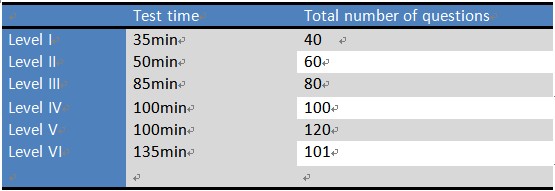
HSK (Level I)
HSK (Level I) assesses test takers’ ability in the application of daily Chinese language. The Level I of the HSK corresponds to the level I of the Chinese Language Proficiency Scales for Speakers of Other Languages (CLPS) and the A1 level of the Common European Framework of Reference for Languages (CEF). Test takers who are able to pass the HSK (Level I) can understand and use very simple Chinese words and phrases, meet basic needs for communication and possess the ability to further their Chinese language studies.
- Test Target
The HSK (Level I) is intended for students who have studied Chinese for a semester (half an academic year), with 2-3 class hours in each week. These students have mastered 150 commonly used words and basic grammar patterns.
- Test Content
The HSK (Level II) test is made up of listening comprehension and reading comprehension sections and contains a total of 40 items.
The test will last for 40 minutes in total(including 5 minutes in which the test takers fill in personal information)
(1)Listening
- There are 5 items in Part One. The recording of each item will be played twice. A phrase and picture will be provided with each item. The test takers should make a True or False judgment based on what they hear.
- There are 5 items in Part Two. The recording of each item will be played twice. A sentence and three pictures will be provided with each item. The test takers should choose corresponding pictures based on what they hear.
- There are 5 items in Part Three. The recording of each item will be played twice. A dialogue and several pictures will be provided with each item. The test takers should choose corresponding pictures based on what they hear.
Part One to Part Three assess test takers’ command of Pinyin’s pronunciation and the understanding of meaning along with the connection to the context, which refers to pronunciation and pragmatics of Chinese language. Test takers are required to judge the pronunciation and the context according to the Pinyin that they heard, and then the exact meaning can be understood. Thus, pronunciation is the most important point for this period of training. The accurate pronunciation, especially the intonation, is the key point for the accuracy of contents’ understanding. In addition, based on the command of pronunciation, the semantics or pragmatics should be emphasized as well.
- There are 5 items in Part Four. The recording of each item will be played twice. For each item, a person will make a statement. Another person will then ask a question and provide 3 possible answers. The 3 possible answers will be listed on the test paper, and test takers can choose one of the answers based on what they hear.
This part is still listening comprehension. Compared to the former parts, this part put more emphasis on pragmatics. The test takers are required not only to understand the literal meaning according to pronunciation, but also to answer the question according to the meanings and effects that come from the use of Chinese language in particular situations. Thus, students should know some models of dialogue in some common situations or daily communication. The flexible use of such knowledge can guarantee the accuracy of answers in shortest time.
(2)Reading
- There are 5 items in Part One. Each item will provide a picture and a phrase. The test takers should judge whether or not they are consistent with each other.
- There are 5 items in Part Two. The test paper will display several pictures. For each item, a sentence will be provided. The test takers need to choose one of the corresponding pictures based on the content of the sentence.
As to reading comprehension, the first two parts pay attention to the understanding of Chinese semantics.Students should know the meaning of some commonly used words,and make the judgment of choice based on related knowledge.
- There are 5 items in Part Three. During this section, 5 questions and 5 answers will be provided. The test takers should match the question with the appropriate answer.
The Part Three pays emphasis on pragmatics. That is, the test takers should be clear about different types of question-and-answer in different situations of dialogue. This is also the assessment of students’ Chinese communication skill.
- There are 5 items in Part Four. Each item will display a sentence with one missing word. The test takers should select one from the answer section and fill in the blank.
The Part Four assesses more on students’ grammatical knowledge though combined with assessment of Chinese semantics. The test takers should not only understand the material accurately, but should know some simple syntax patterns in Chinese, so that they can judge the property of a certain word (noun, verb, pronoun. etc). The good command of Chinese grammar is the foundation of this kind of section.
All items on HSK test paper are shown in Pinyin.
The last item is still the overall requirement for accurate marking of Pinyin.
3、Results Certificate
For the HSK (Level I), three results will be provided including listening, reading and total. The test takers must score at least 120 points total to be considered passing.
| Max Score | Your Score | |
| Listening | 100 | |
| Reading | 100 | |
| Total | 200 |
Summary:
The HSK (Level I) mainly assesses the pronunciation and semantics of Chinese language with few requirement of grammar and no requirement of character writing. Therefore, it is necessary to give in-depth describe of Pining and basic explanations about semantics during the training. Meanwhile, simple and basic grammar training should be concerned as well.
